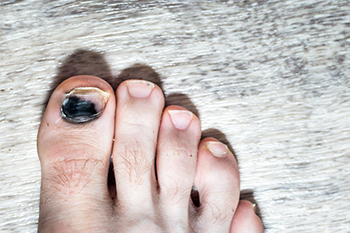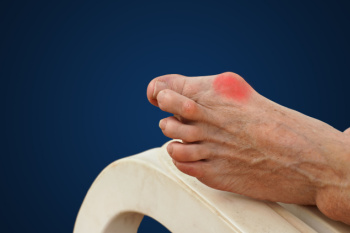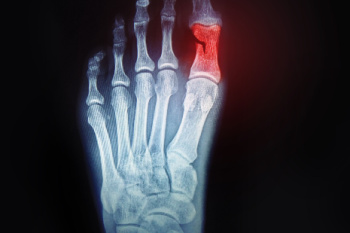Blog
Items filtered by date: May 2024
Treatment for Flat Foot
 Flat foot, which occurs when the foot's arch collapses, can lead to discomfort and pain, particularly in the heel or arch area. This condition may also affect overall foot function. To manage and treat flat feet, a podiatrist might recommend several supportive therapies depending on the severity of the condition and the specific needs of the patient. One common treatment is the use of arch support insoles, which are inserts for the shoes. These insoles help to distribute pressure more evenly across the foot, provide stability, and relieve strain on the arch and surrounding muscles. For cases where insoles alone are not sufficient, a podiatrist may also suggest additional support through structured shoes with built-in arch support, ankle braces, or foot orthotics. Severe cases may require corrective exercises or even surgery to realign the foot and restore function. Regular monitoring and adjustments by a podiatrist are important to effectively manage flat foot and prevent further complications. If you have a flat foot, it is suggested that you make an appointment with a podiatrist.
Flat foot, which occurs when the foot's arch collapses, can lead to discomfort and pain, particularly in the heel or arch area. This condition may also affect overall foot function. To manage and treat flat feet, a podiatrist might recommend several supportive therapies depending on the severity of the condition and the specific needs of the patient. One common treatment is the use of arch support insoles, which are inserts for the shoes. These insoles help to distribute pressure more evenly across the foot, provide stability, and relieve strain on the arch and surrounding muscles. For cases where insoles alone are not sufficient, a podiatrist may also suggest additional support through structured shoes with built-in arch support, ankle braces, or foot orthotics. Severe cases may require corrective exercises or even surgery to realign the foot and restore function. Regular monitoring and adjustments by a podiatrist are important to effectively manage flat foot and prevent further complications. If you have a flat foot, it is suggested that you make an appointment with a podiatrist.
Flatfoot is a condition many people suffer from. If you have flat feet, contact David Lambarski, DPM from Northeast Foot Care. Our doctor will treat your foot and ankle needs.
What Are Flat Feet?
Flatfoot is a condition in which the arch of the foot is depressed and the sole of the foot is almost completely in contact with the ground. About 20-30% of the population generally has flat feet because their arches never formed during growth.
Conditions & Problems:
Having flat feet makes it difficult to run or walk because of the stress placed on the ankles.
Alignment – The general alignment of your legs can be disrupted, because the ankles move inward which can cause major discomfort.
Knees – If you have complications with your knees, flat feet can be a contributor to arthritis in that area.
Symptoms
- Pain around the heel or arch area
- Trouble standing on the tip toe
- Swelling around the inside of the ankle
- Flat look to one or both feet
- Having your shoes feel uneven when worn
Treatment
If you are experiencing pain and stress on the foot you may weaken the posterior tibial tendon, which runs around the inside of the ankle.
If you have any questions please feel free to contact our offices located in Amsterdam and Clifton Park, NY . We offer the newest diagnostic and treatment technologies for all your foot and ankle needs.
Painful Runner's Toe

Runner’s toe, also known as black toenail or jogger's toe, is a common condition among runners and athletes. It occurs when the toes repeatedly hit the front of the shoe, causing trauma to the toenail bed. This trauma can lead to bleeding under the nail, resulting in discoloration that looks black or purple and sometimes pain. The main cause of runner’s toe is the repetitive pressure and impact experienced during running or other high-impact activities. Additionally, poorly fitting shoes or shoes that are too tight can increase pressure on the toes. The condition is more prevalent in long-distance runners or those who frequently engage in activities that involve repetitive toe movement. While runner’s toe is typically not a serious medical concern, it can be uncomfortable and may require treatment if pain or infection develops. Proper footwear can help prevent this condition, allowing runners to enjoy their sport without the discomfort of black toenails. If you have toe pain, it is suggested that you contact a podiatrist who can diagnose and treat runner’s toe.
Toe pain can disrupt your daily activities. If you have any concerns, contact David Lambarski, DPM of Northeast Foot Care. Our doctor can provide the care you need to keep you pain-free and on your feet.
What Causes Toe Pain?
Most severe toe pain is caused due to a sports injury, trauma from dropping something heavy on the toe, or bumping into something rigid. Other problems can develop over time for various reasons.
Toe pain can be caused by one or more ailments. The most common include:
- Trauma
- Sports injury
- Wearing shoes that are too tight
- Arthritis
- Gout
- Corns and calluses
- Hammertoe
- Bunions
- Blisters
- Ingrown toenails
- Sprains
- Fractures (broken bones)
- Dislocations
When to See a Podiatrist
- Severe pain
- Persistent pain that lasts more than a week
- Signs of infection
- Continued swelling
- Pain that prevents walking
Diagnosis
In many cases the cause of toe pain is obvious, but in others, a podiatrist may want to use more advanced methods to determine the problem. These can range from simple visual inspections and sensation tests to X-rays and MRI scans. Prior medical history, family medical history, and any recent physical traumatic events will all be taken into consideration for a proper diagnosis.
Treatment
Treatments for toe pain and injuries vary and may include shoe inserts, padding, taping, medicines, injections, and in some cases, surgery. If you believe that you have broken a toe, please see a podiatrist as soon as possible.
If you have any questions please feel free to contact our offices located in Amsterdam and Clifton Park, NY . We offer the newest diagnostic tools and technology to treat your foot and ankle needs.
How Bunions Develop
 Bunions, medically known as hallux valgus, are bony bumps that form at the base of the big toe. They develop when the bones in the front part of the foot move out of place, while the tip of the big toe pulls toward the smaller toes. This forces the joint at the base of the big toe to stick out. Over time, the movement of the big toe toward the others creates a noticeable bump, which can become painful due to inflammation or arthritis within the joint. It may require treatment ranging from padded shoes and orthotics to surgery. Certain people are genetically predisposed to develop bunions, whereas other cases of bunions may develop due to ill-fitting footwear. High heels or shoes with a narrow toe box can exacerbate this condition. Additionally, conditions like arthritis can also contribute to bunion development by weakening and damaging the cartilage in the joint. If you have a bunion, it is suggested that you visit a podiatrist for treatment options and to prevent it from worsening.
Bunions, medically known as hallux valgus, are bony bumps that form at the base of the big toe. They develop when the bones in the front part of the foot move out of place, while the tip of the big toe pulls toward the smaller toes. This forces the joint at the base of the big toe to stick out. Over time, the movement of the big toe toward the others creates a noticeable bump, which can become painful due to inflammation or arthritis within the joint. It may require treatment ranging from padded shoes and orthotics to surgery. Certain people are genetically predisposed to develop bunions, whereas other cases of bunions may develop due to ill-fitting footwear. High heels or shoes with a narrow toe box can exacerbate this condition. Additionally, conditions like arthritis can also contribute to bunion development by weakening and damaging the cartilage in the joint. If you have a bunion, it is suggested that you visit a podiatrist for treatment options and to prevent it from worsening.
If you are suffering from bunions, contact David Lambarski, DPM of Northeast Foot Care. Our doctor can provide the care you need to keep you pain-free and on your feet.
What Is a Bunion?
A bunion is formed of swollen tissue or an enlargement of boney growth, usually located at the base joint of the toe that connects to the foot. The swelling occurs due to the bones in the big toe shifting inward, which impacts the other toes of the foot. This causes the area around the base of the big toe to become inflamed and painful.
Why Do Bunions Form?
Genetics – Susceptibility to bunions are often hereditary
Stress on the feet – Poorly fitted and uncomfortable footwear that places stress on feet, such as heels, can worsen existing bunions
How Are Bunions Diagnosed?
Doctors often perform two tests – blood tests and x-rays – when trying to diagnose bunions, especially in the early stages of development. Blood tests help determine if the foot pain is being caused by something else, such as arthritis, while x-rays provide a clear picture of your bone structure to your doctor.
How Are Bunions Treated?
- Refrain from wearing heels or similar shoes that cause discomfort
- Select wider shoes that can provide more comfort and reduce pain
- Anti-inflammatory and pain management drugs
- Orthotics or foot inserts
- Surgery
If you have any questions, please feel free to contact our offices located in Amsterdam and Clifton Park, NY . We offer the newest diagnostic and treatment technologies for all your foot care needs.
Plantar Warts Can Be Treated!
Taking Care of a Broken Toe

Broken toes, though often overlooked, can cause significant discomfort and impairment. They typically occur due to trauma, such as stubbing the toe against furniture or dropping a heavy object on it. Symptoms can include pain, swelling, bruising, and difficulty while walking. If you suspect a broken toe, it is important to avoid putting weight on it and refrain from attempting to pop it back into place. Instead, stabilize the toe by taping it to an adjacent toe for support and elevate the foot to reduce swelling. If the pain is severe, the toe appears deformed, or there is numbness or tingling, it is suggested that you seek care from a podiatrist. Further treatment may involve splinting, or in severe cases, realignment, or surgical intervention to promote proper healing and prevent long-term complications.
A broken toe can be very painful and lead to complications if not properly fixed. If you have any concerns about your feet, contact David Lambarski, DPM from Northeast Foot Care. Our doctor will treat your foot and ankle needs.
What to Know About a Broken Toe
Although most people try to avoid foot trauma such as banging, stubbing, or dropping heavy objects on their feet, the unfortunate fact is that it is a common occurrence. Given the fact that toes are positioned in front of the feet, they typically sustain the brunt of such trauma. When trauma occurs to a toe, the result can be a painful break (fracture).
Symptoms of a Broken Toe
- Throbbing pain
- Swelling
- Bruising on the skin and toenail
- The inability to move the toe
- Toe appears crooked or disfigured
- Tingling or numbness in the toe
Generally, it is best to stay off of the injured toe with the affected foot elevated.
Severe toe fractures may be treated with a splint, cast, and in some cases, minor surgery. Due to its position and the pressure it endures with daily activity, future complications can occur if the big toe is not properly treated.
If you have any questions please feel free to contact our offices located in Amsterdam and Clifton Park, NY . We offer the newest diagnostic and treatment technologies for all your foot and ankle needs.

